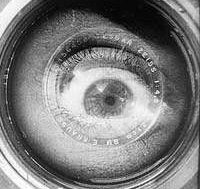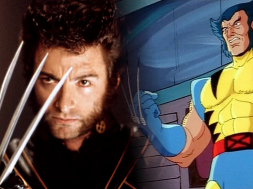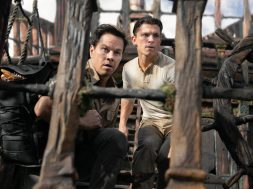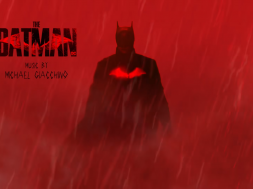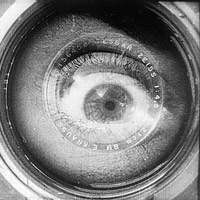
The Crème-de-la-Gore Of Exploitation.
The time has finally arrived. We enter the exploitation endgame. Cue the showdown music…

Looking back over this loosely tied together collection of reviews of the kind of movies polite society avoid like the non-generic plague, it’s easy to laugh (I hope). It’s easy to think, reading these pages, that all exploitation films are simply curious, cheap, frivolous bad-in-a-good-way things to poke fun at with your friends and a few drinks. Something to throw on in the background on a night in that doesn’t require too much higher brain function.
But it’s also easy to forget that quite often these movies are every bit as good, sometimes better, than similar, “quality” mainstream pictures. Not in terms of production values, perhaps, but because their intent is less about the bottom line, and more about creating something. Yes, the whole basis for exploitation movies appears to be about making cheap stories about subjects that shock regular folks and trying to make a quick buck in the film industry. But sometimes, exploitation moviemaking is about outlandish people trying to embrace an art form, resulting in something that might be ropey, but containing more art, and sometimes more heart, than the majority of sub-par product put out by “The Biz” with alarming regularity.
Put Shaft up against a similar studio production – Kiss The Girls or some other focus-group thriller type movie – and see which one you think has more cool per frame by the end.
As such, it seems only fitting to end this terror-filled trilogy with a selection of those exploitation titles that make the leap from being fun, bloody oddities to being serious, effective films that still resonate or every bit as well as their big-budget counterparts.
You may already know them, either by quality, reputation or simply having watched them. But, for all their floppy rubber prostheses and equally floppy acting, for their twisted plots and incongruous dialogue, they deserve mention purely for reminding us that film is one of the greatest, most diverse art forms in existence.
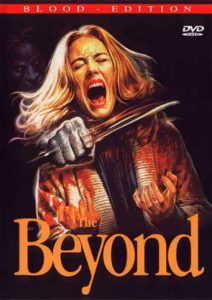 The Beyond (1981), aka Seven Doors Of Death is probably not the title the viewer would consider for the list of movies that are more than the sum of their shoddy parts, but it’s precisely because of this that it works so effectively.
The Beyond (1981), aka Seven Doors Of Death is probably not the title the viewer would consider for the list of movies that are more than the sum of their shoddy parts, but it’s precisely because of this that it works so effectively.
Directed by Italian zombie flick legend Lucio Fulci, The Beyond is, on the face of it, the typical exploitation jaunt – an old hotel is really the gateway to Hell, there are weird supernatural deaths, a few supernatural leaps of logic, and then the undead show up. Think The Shining meets Dawn Of The Dead and The Omen and you’ve about got the basic plot. Or you could listen to Europe’s Seven Doors Hotel, based on the movie, and get the same result.
But there’s far more to this movie than just ticking the trash-horror boxes, with a frisson of bad dubbing on the side.
It’s not any one tangible thing, per se, more a sort of feel. Whether it’s the imagery – a victim’s face fizzing after an acid bath, the ghostly blind girl (Cinzia Monreale) the haunting image of the painting that becomes the gateway to the other side – or the fact that the story plays with religious and metaphysical themes as well as zombies and blood bags, the movie gives off a distinct vibe that seems to be native to all good Spaghetti-horror films. Not horrific as such, but engaging and visceral.
Of course the usual elements that make this an exploitation film of the highest order are still present and correct. You’ll wonder why during the hospital zombie shootout, when the leads discover that shooting the zombies in the head will kill them, they continue to shoot them anywhere but in the head. And you’ll likely question the logic of a New Orleans hotel having a basement. The acting, meanwhile, is somewhat better than the exploitation standard, mostly marred by the fact that it’s dubbed from Italian rather than anything being wrong with the performances.
All these things are secondary, though, to the captivating sense of texture you get from the movie; from the balmy, sweaty New Orleans, through the cold clinical hospital section, to the disturbing thrum of the finale, there’s a depth to the direction, the cinematography and the story that’s missing from most of these kinds of films, that makes The Beyond a must-own, or at least a must-watch movie.
It’s nigh on impossible to talk about exploitation cinema without mentioning certain names – Pam Grier, Roger Corman, Jim Kelly and Lamberto Bava, to name but a few – since they are the best known, most successful, most creative, or simply the most synonymous with the genre, the style, and the culture of exploitation.
 When it comes to films that are synonymous with exploitation, The Last House On The Left (1972) is top of the list. And, quite possibly, the best of the list.
When it comes to films that are synonymous with exploitation, The Last House On The Left (1972) is top of the list. And, quite possibly, the best of the list.
With its notorious reputation, its recent foray into remake territory and the fact that director Wes Craven made two successful horror franchises in the intervening years, you could be forgiven for forgetting just how scary, and just how good Last House actually is.
Craven’s rape-revenge picture fleshes out from the simple premise to create an engrossing cinematic adventure, navigating a whole range of emotional archipelagos, going from humorous to dramatic, to seedy, without ever losing the palpable overall creeping sense of dread at its core.
He puts together scenes of barely glimpsed horror with those of down-home drama, dream-fuelled strangeness, action and comedy, using a combination of striking visual images (Weasel’s proto-Nightmare On Elm Street dream-death for example) and jarringly inappropriate soundtrack (the jaunty theme for Krug and his gang) to disturb and agitate the viewer. The result is nothing short of enthralling.
Even beyond the direction, it’s obvious that Last House On The Left is a cut above most exploitation fare. A strong, often witty script drives the plot in a fractured yet relentlessly paced fashion, aided by Craven’s intercutting between the attack and murder of Mari and Phyllis and the sedate home life of Mari’s parents, with the two plot threads converging in the chaotic, vicious and vengeful final act.
The acting, too, is some of the best in the genre. Anchored by a magnetic villainous turn from David Hess, the casts’ performances are never less than suited to the role, Marc Sheffler as Junior and Fred Lincoln as Weasel in particular. Craven succeeds in making sure that the audience is behind the victims so that when things get bloody, everything is justified, and it’s borne out by the performances of Richard Towers and Cynthia Carr to chilling effect.
They are ably supported by Marshall Anker and Martin Kove (The Karate Kid’s John Kreese) who provide the all-too necessary comic relief from the cinematic torment that Craven heaps on both the girls and the audience.
Despite its low-budget trappings, The Last House On The Left comes together into an effective, and downright awesome piece of filmmaking.
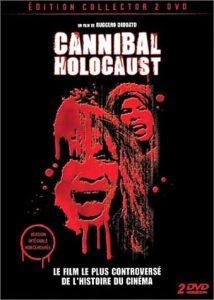 Finally, we come to Ruggero Deodato’s Cannibal Holocaust (1980) – a film that is considered the most notorious movie in existence, and is the definition of the term “exploitation”.
Finally, we come to Ruggero Deodato’s Cannibal Holocaust (1980) – a film that is considered the most notorious movie in existence, and is the definition of the term “exploitation”.
If you don’t already know, the film follows an attempt by an anthropologist (Robert Kerman) to find a group of missing documentary filmmakers, finding that they’ve been murdered by a cannibal tribe. Managing to rescue the footage the crew shot before their deaths, the second half of the film reveals that they were not, as you might think, innocent victims.
This description doesn’t begin to do the film justice. Predating The Blair Witch Project with its pseudo-documentary style, the movie first and foremost exploits the audience perception of “realism”, squeezing the narrative and the imagery to repugnant, compelling effect. This is a genius move, as Deodato cleverly circumvents usual exploitation setbacks like bad SFX by playing things for the truth and manipulating the medium, in terms of society and terms of actually screwing with the film stock, to give the whole thing a veneer of reality that adds to the immersiveness of the piece.
In fact, it works so well that after its release, the director was arrested for the murder of his leading actors. The cast had in fact signed a disappearance agreement, meaning they had to stay out of sight for a year after the film’s release. If that’s not exploitation of the art of film, I don’t know what is.
But the exploitation goes significantly and horrifically deeper than that. The movie features the actual murder of people in the form of real-life docu-footage of firing squads, and the live killing of animals specifically for the film. It’s truly brutal, and in the worst of taste possible, but its presence only serves to make the fake horror seem more real, manipulating what could’ve been a simple gorehound experience into something much more organically and basely terrifying.
The cast also perform admirably, making a definite emotional impression, and playing well along with the gruesome events and stylings that make up the narrative. Placed in this context, what are usually the audience’s way into the story are again twisted into another device with which to bludgeon fear out of the viewer.
And that’s the real thrust of Cannibal Holocaust. The film is a concentrated effort to draw repulsion from whosoever watches it – it’s telling that Deodato was inspired by the way the news media present violence – and in that respect, it is ruthlessly effective.
You may not like it. Even if you do, you still probably won’t enjoy it. But that doesn’t mean you shouldn’t watch it.
And so there we have it, the end of the Rampage. The bodies have been laid on the floor. All the squibs have gone off. The clichés are finally coming to an end.
But this is only a small sampling of the best of the worst of what, for some, is the most interesting and enjoyable style of film there is. There’s decades worth of exploitation-y goodness to be had, from the hilariously bad Zombie Holocaust, whose trailer alone is fantastic, to the entire Roger Corman back catalogue, which deserves a review rampage all its own.
And the exploitation style is still alive and multiplying like so many extra terrestrial eggs in the 21st Century, with the likes of Nazi torture horror The Human Centipede, Robert Rodriguez’s Mexploitation actioner Machete, and the 3-D Japanese effort Big Tits Zombie in 3-D (Deadly DD-Cups) flying the flag for the style, proving once and for all that as long as you can imagine it, you can exploit it.
Oh and let’s not forget 1981’s Inseminoid, otherwise known as Alien with added plastic sex-pipe.
